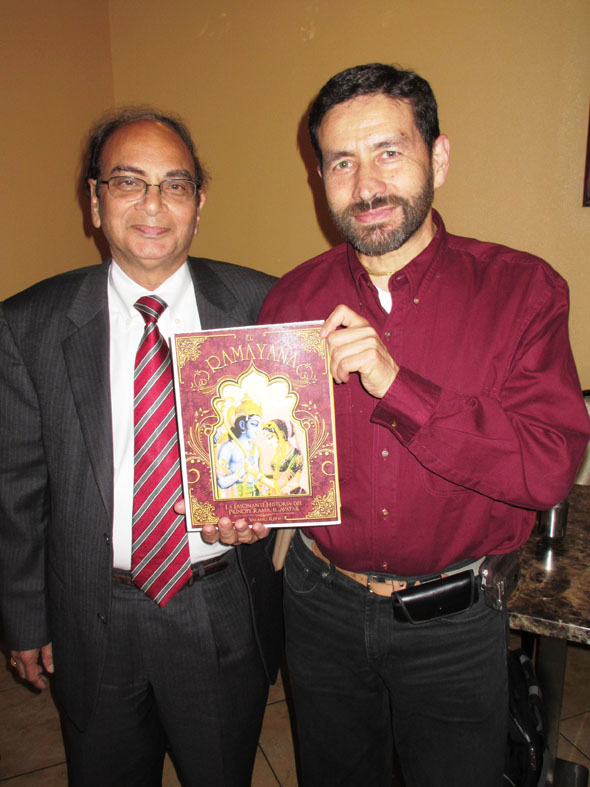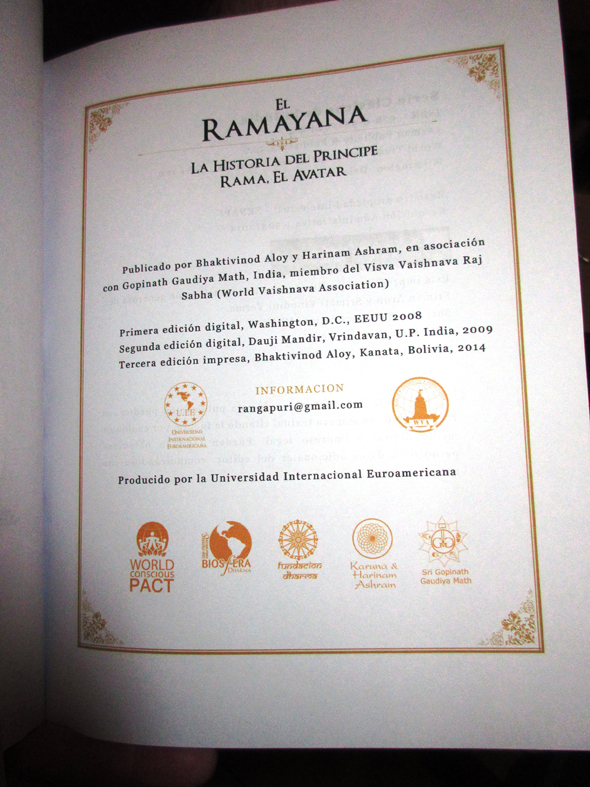First Spanish Translation of Ramayana Seeks to Reach the Hearts of Latin Americans

With Ranagapuri Das, the translator of the Ramayana into Spanish, is Dr. Arun Verma, a devotee of Lord Rama, who has created the Dusserah and Diwali Mela spectacle in Houston. Rangapuri Das visited Houston in late October and spoke at the Sita Ram Foundation’s Ram Leela program.
By Jawahar Malhotra
HOUSTON: The wisdom of the Sage Valmiki in his rendition of the deeds and life of the Hindu God Rama, the seventh avatar of Vishnu, has been read and deciphered by generations of devoted Hindus who have been imbibed by his verses full of kernels of knowledge and lessons that lie waiting those who grasp them. For centuries, these verses complied in the Ramacharitasmanas and played out as the Rama Leela during the Diwali season have framed the mindsets and code of conduct for millions of Hindus the world over. Translations have been available in many Indian languages and a few other foreign ones, most notably English.
If language frames the context and meaning of an idea or thought that elicits the reaction of a person, then abstract ideas require a more indepth understanding of the type that suggests that they speaker has experienced that journey and can share the lessons effortlessly and simply. It is as if they can shed valuable bits of knowledge with every breath they exhale.

The opening page of the Spanish language Ramayana, which is only currently available in limited release.
Such was the feeling that Rangapuri Das exuded as he sat down for a thali dinner at Maharaja Bhog with reporters during his short visit to the Bayou City in mid-October. As the guest of Dr. Arun Verma, the head of the Sri Sita Ram Foundation which has brought the Ram Leela and the Dusserah and Diwali Mela to Houston for the past several years, he had been given a chance to briefly speak onstage at the Cullen Auditorium before the play (see IAN dated Oct. 17, 2014) and closed with a shlok in Sanskrit.
Das was on a tour of the US to bring attention to the culmination of his 21 year labor of love and devotion to translate Valmiki’s Ramayana into second most common language in the world, Spanish. He would travel onwards to San Francisco and then to the UK to make presentations there of his work, but while in Houston, he presented the first private printing of 50 copies sponsored by Verma and his wife, giving one copy to University of Houston President Renu Khator at the Ram Leela play. To keep the costs down, Das intends to get the over 900 pages, color, illustrated translation, done in the style of illuminated books, published in India.
Born Reynaldo Cuadros Anaya 56 years ago in Bolivia, Das became an ISKCON devotee of Swami Prabhupada and first read the Bhagwad Gita 35 years ago, around the same time that he was initiated as Rangapuri Das, a turning point in his spiritual journey. He received his undergraduate degree in political science from Columbia University and then a doctorate in Social and Cultural Anthropology from the International School in Brussels, Belgium.
Anaya has been a professor of science at the Andres Bello University in Santiago, Chile and at an Institute is La Paz, Bolivia. He was appointed Bolivia’s Ambassador to the Permanent Representative to the Organization of American states from 2006 to 2009, and later served as Bolivia’s Liaison to the White House for six months and later as an Ambassador to several other countries for two years. His son, 35, has a degree from Berkley, California and teaches Indian Studies there; Das’ second wife is also a Bolivian Vaishnav and devotee and his daughter studies environmental engineering.
But Das’ pursuit of bringing the words and wisdom of the Ramayana to the Spanish speaking world has led him on a quest learn Sanskrit and visit India where he took guidance from his guru who passed away some years ago. He has been a brahmachari for nine years, a member of the World Vaishnava Association and finished the translation in 2008 in the holy city of Vrindavan, near Mathura, Uttar Pradesh, a work that he thought would take him only six months but consumed 21 years of his life.
“The Ramayana is an important text for the world to recognize right and wrong, evil and good,” said Das in the slow, calm, deliberate manner of someone at peace with himself. “Nowadays, people create new ways to interact, but Nature has already set these ways for society and the modern world should learn from it.” Das has visited many countries neighboring India, like Malaysia, Indonesia, Singapore, and he says they all acknowledge India as the Motherland of their cultures.
His hope is that the Spanish translation will allow people in Latin America to read the Ramayana much as they read the Iliad and Odyssey by the ancient Greek author Homer and believes that everything Greek come from India, that Aristotle told Alexander the Great to go to India, learn about the Aryans and bring back ancient texts, 146,000 of which are stored in an English University. Das has spoken with the Minister of Education in Bolivia about making the Spanish translation of the Ramayana available in high schools as a book that teaches the basic principles of life and not just as a religious book. “The Ramayana is not mythology,” he insists, “It has many scientific connections.”
The Spanish translation is indeed marvelous to behold with its appealing lithography and colorful panels and 25 page Appendix of explanations. Arun Verma was introduced to Das in Washington, DC in 2000, as someone who was writing about the Ramayana and since then the two men have stayed in touch and Verma wanted to do a book launch in Houston this year. Now, with the work done, they two men want to penetrate the Latin American market and spread the knowledge in the ancient text for future generations to learn from.
To see the Spanish Ramayana, visit http://www.shrisitaram.org/spanishr/ramayana10/ramayana10a.pdf
